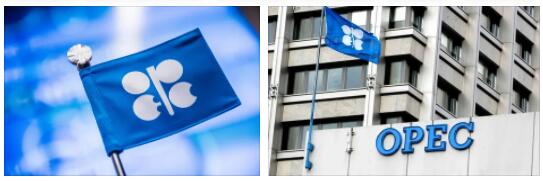SPOTLIGHT : Ecuador has revoked its membership in OPEC with effect from January 1, 2020. The country suspended its membership in December 1992, but rejoined OPEC in October 2007. After Qatar also left OPEC on January 1, 2019, OPEC currently has 13 members (as of February 2021).
Background
According to psyknowhow, OPEC is an international organization that was founded in Baghdad (Iraq) in September 1960 by the five producing and exporting countries Iraq, Iran, Kuwait, Saudi Arabia and Venezuela. OPEC has been based in Vienna (previously Geneva) since 1965.
Goals
Coordination of oil policies in the producing countries; Stabilization of world market prices, among other things, by regulating production volumes and “fair returns” for investors in the oil industry. Solidarity is to be exercised in the case of sanctions by the buyer states to which one or more member states are exposed when international oil companies comply with OPEC decisions.
Members (13)
- 5 Middle East countries: Iraq, Iran, Kuwait, Saudi Arabia, United Arab Emirates (UAE)
- 7 African countries: Algeria and Libya in North Africa and Angola, Equatorial Guinea, Gabon, Nigeria and the Republic of the Congo (since June 22, 2018) in West and Central Africa
- 1 South American country: Venezuela
Indonesia was a member from 1962-2009, reactivated its membership in January 2016 and left OPEC again in December 2016. A tabular overview of the OPEC member states with explanations can be found below.
The oil production volumes of the OPEC countries in 2019
The graphic compares the oil production volumes in 2019 of the OPEC countries in thousands of barrels per day (barrel per day = b / d). The pillars of the current 13 members are color-coded as follows: Near / Middle East in blue, West Africa in brown, North Africa in yellow and South America in green. By far the strongest producing country is Saudi Arabia (left column, cut off).
The two pie charts show the globally relatively low share of OPEC at around 39% of global oil production and almost 50% of global oil exports – both figures with a continuing downward trend. The increasing importance of the African continent is remarkable.
The foreign trade flows of OPEC oil in 2019
The graphic shows the export volume in 2019 for the three OPEC regions Middle East, Africa and South America. The three most important recipient regions, North America, Europe and Asia-Pacific, are marked in yellow (not the respective individual states!). The thickness of the bar roughly reflects the size of the export volumes, measured in thousands of barrels per day (barrel per day – b / d).
The Middle East accounts for around 80 percent of all OPEC trade. It is noticeable that in 2019 the bulk of Middle East exports – but also, increasingly, African exports – go to the Asia-Pacific region. Even the declining shares of South America (i.e. Venezuela) in OPEC trade are primarily going to the Far East.
The foreign trade flows in 2006 for comparison
The graphic shows the export volume in 2006 of the then thirteen OPEC countries for comparison, whereby the Middle East is only rated as a region. Here, too, the thickness of the bar roughly reflects the size of the export volumes, but in a weaker form for exports to Asia.
What is striking is the dominance of the Middle East and the already discernible competition between North America and Europe on the one hand and between these two regions and the Asia-Pacific region on the other.
Please note: the total amount of OPEC exports was only about 55% of global oil exports. If Russia and other exporting countries were included, the picture would be different.
Note: The data on this website are based on information from the OPEC (Annual Statistical Bulletin 2020).
Table of
members of OPEC (13)
with their year of entry and explanations of the year of membership or re-entry.
OPEC differentiates between founder members (5) and full members, i.e. countries whose application for membership was accepted by the conference with a three-quarters majority. The statutes also allow associate membership.
| Algeria | (1969) |
| Angola | (2007) |
| Equatorial Guinea | (2017) |
| Gabon | (1975) – Membership ended in January 1995. Re-entry took place in July 2016. |
| Iraq | (1960) |
| Iran | (1960) |
| Kuwait | (1960) |
| Libya | (1962) |
| Nigeria | (1971) |
| Republic of the Congo | (2018) |
| Saudi Arabia | (1960) |
| Venezuela | (1960) |
| United Arab Emirates (UAE) | (1967) |
Note:
– Indonesia was a member from 1962 to 2009. Membership was reactivated in January 2016 and deactivated again in December 2016.
– Qatar has been a member since 1961. It ended its membership on January 1st, 2019.
– Ecuador had been a member since 1973. Membership was suspended from December 1992 and was reactivated in October 2007. Ecuador ended its membership on January 1st, 2020.
Comment
The role of OPEC in the power play of the world economy and world trade has increased since its first effective showdown in 1973, when the price of oil rose significantly in connection with the Yom Kippur war (Israel vs. Egypt and Syria) and the Arab oil boycott (OAPEC), compared to the western industrialized countries due to the following factors.
On the one hand:
The energy dependence of the consumer countries on oil is proportionally much lower today (!) Than in the 1970s.
The consumer countries have diversified their purchase strategies and are increasingly purchasing oil from producing countries that are not members of OPEC.
In the meantime, some consumer countries have developed their own considerable crude oil reserves (e.g. Great Britain, Norway, Russia and the USA).
The OPEC members themselves often do not adhere to their own price and subsidy agreements, with which the crude oil quantities brought onto the world market are artificially reduced and thus kept more expensive for consumers.
On the other hand:
The enormous hunger for energy in the so-called emerging countries (China, India, Brazil, etc.) intensifies global competition for energy resources and thus strengthens the position of OPEC.
The organization comprising 13 countries at the beginning of 2021 has developed, with varying degrees of efficiency, into a formidable economic global player, which, however, only sells around 50% of the global oil export volume – with a continuing downward trend.
Despite the weaknesses mentioned above, OPEC is repeatedly able, for example in 1999/2000, to achieve an increase in the price of oil by greatly reducing oil production, which falls again and again in view of the overproduction of certain OPEC countries. Cartel-linked producers such as Mexico, Norway, Russia or Oman also often make commitments to reduce funding, for example in November / December 2020.
The oil cartel is a “prime example” of international solidarity: On the one hand, European producing countries such as Great Britain and Norway do not shy away from profiting from the OPEC price increases by aligning their oil prices. On the other hand, every price increase not only hits the financially relatively strong industrialized countries, but especially those developing countries that have no alternative energies and no financial reserves, disproportionately hard.
But the market can regulate a lot here as well: For example, a decline in income from oil exports would force many of the very wealthy OPEC members to take extensive austerity measures and could thus result in social upheavals; on the other hand, an increase in the global hunger for oil and thus in export revenues, in particular, would allow the Arab OPEC countries to make extensive capital investments on the world market, especially in the western industrialized countries.
In September 2000, at its first summit since 1975, on the occasion of the 40th anniversary of the founding, OPEC called on the industrialized countries to lower gasoline and diesel taxes, as these accounted for the largest part of the final price of fuels. Our opinion: “Where you are right, you are right…” – also in 2021!

